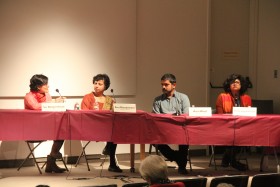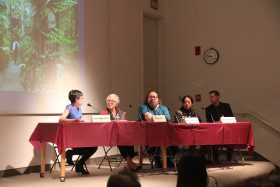Over the last 50 years, Asia has become home to more megacities than any other continent in the world. These cities – specifically Beijing, Shanghai, Delhi, Mumbai, and Seoul – are the inspiration for the Museum of Fine Arts’ ‘Megacities Asia’ exhibition, on display at the Boston museum from April 3 to July 17. The exhibition features the work of artists like Hema Upadhyay, Ai Weiwei, Subodh Gupta, Choi Jeong Hwa, Asim Waqif, Aaditi Joshi, Song Dong, and Hu Xiangcheng, among others.
The Harvard South Asia Institute hosted an event of the same name on March 24 at Harvard, in partnership with the Museum of Fine Arts, Boston (MFA), Harvard’s Asia Center, Department of Art and Architecture, Fairbank Center for Chinese Studies, Korea Institute, Reischauer Institute of Japanese Studies, and Weatherhead Center for International Affairs, which featured academics and scholars of Asia in conversation with several of the artists whose work is on display at the MFA.
Laura Weinstein and Al Miner of the MFA introduced the event and explained that the sheer scale and rapid pace of urbanization is influencing artists tremendously. Artists are using their creativity to comment on these changes. In the exhibition, Weinstein explained that the artists use mostly “found” objects, such as dishes, doors, and plastic bags, to evoke the human body’s experience in a megacity.
The first panel, moderated by Sai Balakrishnan, Harvard Graduate School of Design, focused on the politics and pluralities of architecture and urban planning in Delhi and Mumbai. Balakrishnan encouraged the panelists to offer new ways of thinking about sustainability.
Anu Ramaswami, University of Minnesota, showed that urban ecology can be used to understand how cities change. Her research focuses on sustainability through the lens of urban material and energy flows. These materials tell a startling story of change. For example, China used more cement in 3 years than the US did in the entire 20th century. For Asian megacities, the challenge moving forward will be preserving the unique sustainability of each city by combining global practices with vernacular practices.
Combining the old and new was a central theme throughout the discussions. Artist Asim Waqif said that India needs to mix vernacular ideas with new technology as cities continue to grow. Waqif shared several videos of his work, which incorporates architecture, art, and design to address concerns of ecology and anthropology. He has done extensive research on vernacular systems of ecological management.
Chitra Venkataramani, South Asian Studies Fellow at the South Asia Institute, shared her research on cartographic images and visual transformations of cities. Using a case study of a recent fire at waste dump in Mumbai can help planners understand how spaces are transformed, and shows how cartographic images can shed light on the visual politics of urban change.
The second panel, moderated by Laura Weinstein, MFA, explored the urban life of city dwellers in South Asia, China, and Japan, and how that daily life has changed as cities grow. The discussion featured Chinese artist Hu Xiangcheng, who is interested in how cities transform from ancestral to modern.
Japan’s urbanization also provides insights into Asian megacities. Theodore Bestor, Director of Harvard’s Reischauer Institute of Japanese Studies, offered a glimpse into his research on the evolution of Tokyo, and the social impact of its relationship with the built environment. Tokyo, now preparing for the 2020 Olympics, has been remade many times throughout its history, and Bestor explained that the city incorporates lessons from its past to better plan for the future.
Martha Chen, Harvard Kennedy School, discussed how the informal nature of employment presents challenges in rapidly urbanizing cities. In India, 80 percent of workers are employed informally, such as those who work at home or on the street. Most urban planning does not take this into account. Informal employment is usually stigmatized, and Chen said that cities, as they urbanize, are becoming increasingly hostile towards these types of workers. It all the prompts the question: what is heritage? Chen posed this question to the panel: “Why is an ancient fort considered heritage, but not an artisan village or a historic market?”
Formal and informal; modern and vernacular: Chen said that how these competing ideas co-exist will be “the challenge of our century.”
The ‘Megacities Asia’ exhibition will be on display at the MFA in Boston starting April 3. Click here to learn more.
-Meghan Smith


